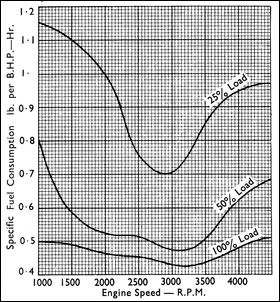Does the pulse-and-glide thing really work for maximizing fuel economy? It seems to me that maintaining a constant speed would be better, and less annoying to others…
It works because the brake specific fuel consumption of gasoline engines drops off dramatically when it is run at part throttle. Low speeds take low horsepower and a 100 hp engine throttled down to 10 hp is a very inefficient way to make 10 hp. By making the engine make 100 hp for 10 seconds and then letting the car coast for 90 seconds, the engine produces an average of 10 hp at the same brake specific fuel consumption as it would have at 100 hp.
chart came from http://www.autospeed.com/cms/A_110216/article.html
What?
BLE simply pointed out that reciprocating piston engines make far more efficient heating furnaces or water heaters than they are producers of torque. 70% of your fuel dollar is used to heat water and exhaust gas…These BTU’s, which you paid dearly for, are blown off into the atmosphere along with the heat from the brakes. About 25% of your fuel dollar actually moves your car, the rest is wasted.
In a Hybrid, most of the braking energy is captured and recycled. Look what a difference just THAT improvement makes…
If you have a big oversized engine it is costing you and by using that technique you can reduce the amount it is costing you. Of course buying cars that are not over powered means you can do even better. You will be working the engine more efficiency and carrying less weight and avoiding all that playing around pulsing as well as avoiding the safety issues with pulsing.
Dale Earnhardt’s crew chief apparently thinks it works.
http://www.autoracingdaily.com/article/roller-n-coaster-dale-earnhardt-jr-ends-the-victory-draught/
Who knows, maybe in the future, it may become standard operating procedure during the yellow flag laps.
One can argue the theoretical benefits of pulse-glide, but putting it into practice is another matter. A non-engineer driver does not really know his optimum rpm, how long to accelerate and to what final speed, and all them other details. He gets no instrument feedback. Bottom line – he can try his own guesswork version of pulse-glide, never knowing if he found a sweet spot for all parameters or if he is actually far off and wasting considerable fuel.
So maybe it works for the right driver with the right car. For the rest of us, I recommend the traditional method of gentle acceleration and steady speed. At least you know!
